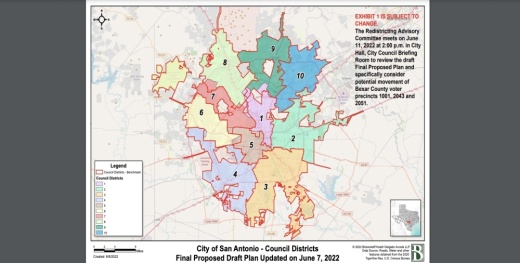San Antonio City Council on June 16 unanimously approved a map of new council district boundaries, capping an eight-month process spurred by the population increase found in the 2020 U.S. census.
A council-appointed advisory committee of 23 residents worked with city staff since October to examine data, hold meetings and collect public input before recommending a redistricting plan.
The 2020 census pointed to a San Antonio population of 1.43 million. City officials said the redistricting panel was tasked to balance the population of each council district; the ideal size is 143,494 per district.
Local officials said the final approved redistricting plan ensures that the level of deviation from the ideal population is no more than 5% per district. The new district boundaries will be applied to San Antonio’s next scheduled City Council election in May 2023.
“The new council district boundaries will ensure balanced population in each council district and continue to shape the future of our growing city,” City Attorney Andy Segovia said.
Prior to approving the new redistricting map, the city was looking at population imbalance in places such as District 8, where the 2020 census population was 18.8% over the ideal district population size.
The new plan rebalances District 8 at 3% over the ideal size, with many District 8 residents in eight neighborhoods and subdivisions shifted into District 7.
District 5, which had been 16.56% below the ideal district size, is also rebalanced in the new map.
District 5 is now 4.9% under the ideal population number in the new plan, with having gained all of the Collins Garden neighborhood from District 1, and now splitting two other neighborhoods with two other districts.
Elsewhere, the new map splits the Vance Jackson neighborhood between Districts 8 and 1, moves Greater Harmony Hills from District 9 wholly into District 1, and shifts the Lorrence Creek Preservation Association from District 10 entirely into District 9.
Neither District 2 nor District 3 had any boundary changes.
According to a news release, the advisory committee held map-drawing sessions and public meetings between January and June, virtually and in person.
The committee co-chairs, Bonnie Prosser Elder and Rogelio Saenz, praised their colleagues’ work; this was the first time an appointed citizens panel led the decennial redistricting process. In previous redistricting efforts, council members worked with city staff to draw up district boundaries.
“Our goal was to balance the population across the city while receiving significant, informative public input throughout the process. With the public’s input, we were able to create districts that are fair and representative of our city,” Prosser Elder said.
Saenz said the committee dedicated itself to a transparent and inclusive process focused on residents’ input.
“After many meetings, we came to an unanimous decision to adopt a map that unifies neighborhoods, preserves the cohesion of communities of interest, and most importantly, we strived to provide a space for residents to be part of this process,” Saenz said.
Council members lauded the committee’s results, and agreed with the panel co-chairs that the 2022 redistricting process—this time heavily involving residents—was much improved compared with redistricting programs of decades past.
Mayor Ron Nirenberg said this redistricting effort was an attempt to move the council district map-making process from the council and city staff and into residents’ hands.
“I think we all did our best to do that,” Nirenberg said.
But the latest redistricting process did undergo some criticism. One proposal, which eventually was rejected, called for moving Brackenridge Park completely into District 1. The new map retains a split of the park between Districts 1 and 2.
In another part of the now-approved redistricting plan, members of the Greater Harmony Hills Neighborhood Association protested their move from District 9 to District 1, which extends across the center of town and includes the central business district.
The final map also keeps the downtown/central business district within District 1. The San Antonio Chamber of Commerce led opposition to a proposal to split the downtown business sector between Districts 1 and 5.
“As San Antonio continues to recover from the challenges of the last two years, we are confident that a strong and unified central business district will benefit our entire city,” a chamber news release said.





